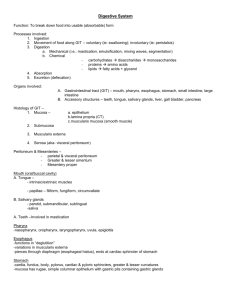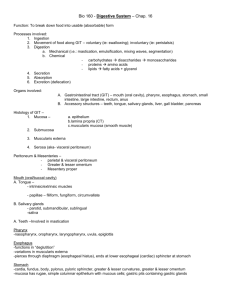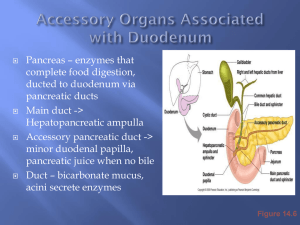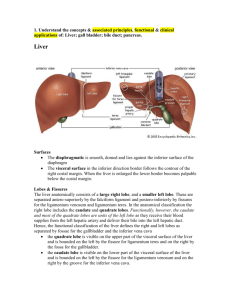Bio 242 Unit 1 Lecture 3 printable
advertisement
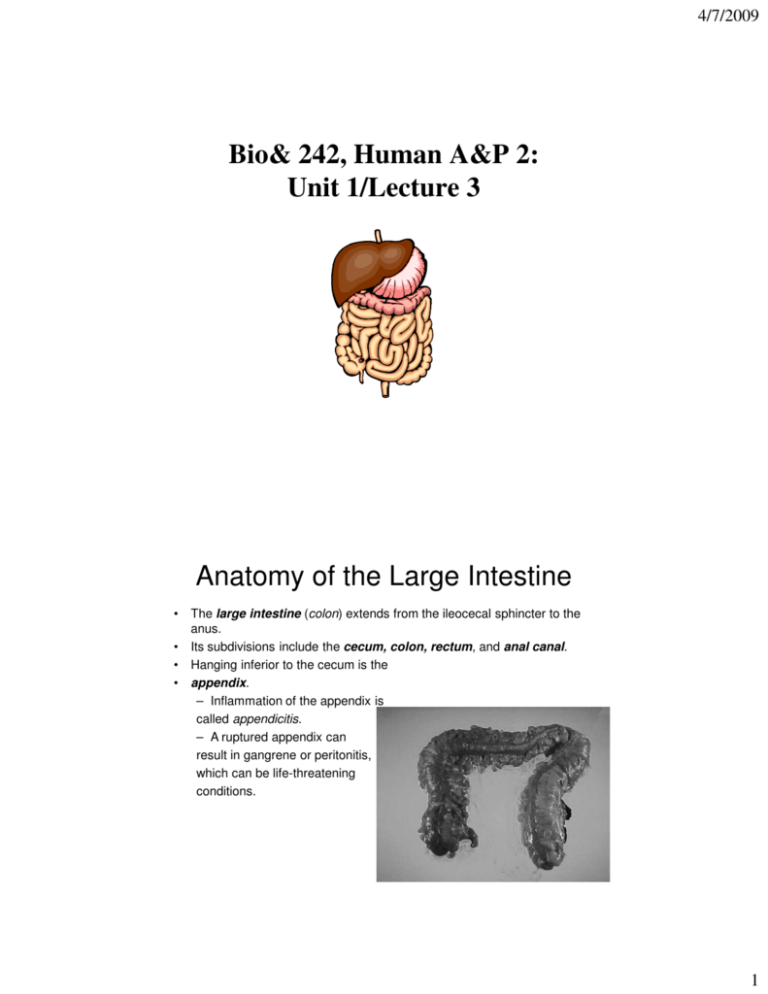
4/7/2009 Bio& 242, Human A&P 2: Unit 1/Lecture 3 Anatomy of the Large Intestine • • • • The large intestine (colon) extends from the ileocecal sphincter to the anus. Its subdivisions include the cecum, colon, rectum, and anal canal. Hanging inferior to the cecum is the appendix. – Inflammation of the appendix is called appendicitis. – A ruptured appendix can result in gangrene or peritonitis, which can be life-threatening conditions. 1 4/7/2009 Anatomy of Large Intestine • • • • 5 feet long by 2½ inches in diameter Ascending & descending colon are retroperitoneal Rectum = last 8 inches of GI tract anterior to the sacrum & coccyx Anal canal = last 1 inch of GI tract – internal sphincter----smooth muscle & involuntary – external sphincter----skeletal muscle & voluntary control 2 4/7/2009 Mechanical Digestion in Large Intestine • Mechanical movements of the large intestine include haustral churning, peristalsis, and mass peristalsis. • Peristaltic waves (3 to 12 contractions/minute) – haustral churning----relaxed pouches are filled from below by muscular contractions (elevator) – gastroilial reflex = when stomach is full, gastrin hormone relaxes ileocecal sphincter so small intestine will empty and make room – gastrocolic reflex = when stomach fills, a strong peristaltic wave moves contents of transverse colon into rectum by Mass peristalsis Chemical Digestion in Large Intestine • No enzymes are secreted only mucous • Bacteria ferment – undigested carbohydrates into carbon dioxide & methane gas – undigested proteins into simpler substances (indoles)----odor – turn bilirubin into simpler substances that produce color • Bacteria produce vitamin K and B in colon • Converts chyme into feces 3 4/7/2009 Functions of the Large intestinal Mucosa 1. Goblet cells: create mucus that lubricates colon and protects mucosa. 2. Absortive cells: Maintains water balance, solidifies feces, absorbs vitamins and some ions Absorption & Feces Formation in the Large Intestine • Some electrolytes---Na+ and Cl• After 3 to 10 hours, 90% of H2O has been removed from chyme • Feces are semisolid by time reaches transverse colon • Feces = dead epithelial cells, undigested food such as cellulose, bacteria (live & dead) 4 4/7/2009 Absorption and Feces Formation in the Large Intestine • The large intestine absorbs water, electrolytes, and some vitamins. • Feces consist of water, inorganic salts, sloughed-off epithelial cells, bacteria, products of bacterial decomposition, and undigested parts of food. • Although most water absorption occurs in the small intestine, the large intestine absorbs enough to make it an important organ in maintaining the body’s water balance. Defecation Reflex • The elimination of feces from the rectum is called defecation. • Defecation is a reflex action aided by voluntary contractions of the diaphragm and abdominal muscles. The external anal sphincter can be voluntarily controlled (except in infants) to allow or postpone defecation. 5 4/7/2009 Defecation • Gastrocolic reflex moves feces into rectum • Stretch receptors signal sacral spinal cord • Parasympathetic nerves contract muscles of rectum & relax internal anal sphincter • External sphincter is voluntarily controlled Defecation Problems • Diarrhea = chyme passes too quickly through intestine – H20 not reabsorbed • Constipation--decreased intestinal motility – too much water is reabsorbed – remedy = fiber, exercise and water Clinical Concerns • Colonoscoy is the visual examination of the lining of the colon using an elongated, flexible, fiberoptic endoscope. • Occult blood test is to screen for colorectal cancer. 6 4/7/2009 PANCREAS • The pancreas is divided into a head, body, and tail and is connected to the duodenum via the pancreatic duct (duct of Wirsung) and accessory duct (duct of Santorini). • Pancreatic islets (islets of Langerhans) secrete hormones and acini secrete a mixture of fluid and digestive enzymes called pancreatic juice. Accessory organs of the GI Tract Pancreas: Produces 1.2L to 1.5L of pancreatic juices daily. Pancreatic juice consists of a bicarbonate solution containing salts and digestive enzymes. Bicarbonate helps buffer acidic chyme from the stomach 7 4/7/2009 Histology of the Pancreas • Acinar cells: Secrete pancreatic juice, a mixture of bicarbonate fluid and digestive enzymes. • Islet of Langerhans: Alpha cells- glucagon Beta cells- insulin Delta cells- somatostatin F-cells- pancreatic polypeptide Acini Islet of Langerhans Neural and Hormonal Control of the Pancreas Secretin: acidity in intestine causes increased sodium bicarbonate release GIP: fatty acids & sugar causes increased insulin release CCK: fats and proteins cause increased digestive enzyme release 8 4/7/2009 LIVER AND GALLBLADDER • The liver is the heaviest gland in the body and the second largest organ in the body after the skin. • Anatomy of the Liver and Gallbladder • The liver is divisible into left and right lobes, separated by the falciform ligament. Associated with the right lobe are the caudate and quadrate lobes. • The gallbladder is a sac located in a depression on the posterior surface of the liver. Histology of the Liver • The lobes of the liver are made up of lobules that contain hepatic cells (liver cells or hepatocytes), sinusoids, stellate reticuloendothelial (Kupffer’s) cells, and a central vein. • Bile is secreted by hepatocytes. • Bile passes into bile canaliculi to bile ducts to the right and left hepatic ducts which unite to form the common hepatic duct. • Common hepatic duct joins the cystic duct to form the common bile duct which enters the hepatopancreatic ampulla. 9 4/7/2009 Pathway of Bile Secretion • Bile capillaries • Hepatic ducts connect to form common hepatic duct • Cystic duct from gallbladder & common hepatic duct join to form common bile duct • Common bile duct & pancreatic duct empty into duodenum Accessory organs of the GI Tract Liver: Produces .8L to 1.0L of bile per day – yellow-green in color & pH 7.6 to 8.6 • Components – water & cholesterol – bile salts = Na & K salts of bile acids – bile pigments (bilirubin) from hemoglobin molecule • globin = a reuseable protein • heme = broken down into iron and bilirubin 10 4/7/2009 Bile - Overview • Hepatic cells (hepatocytes) produce bile that is transported by a duct system to the gallbladder for concentration and temporary storage. • Bile is partially an excretory product (containing components of worn-out red blood cells) and partially a digestive secretion. • Bile’s contribution to digestion is the emulsification of triglycerides. • The fusion of individual crystals of cholesterol is the beginning of 95% of all gallstones. Gallstones can cause obstruction to the outflow of bile in any portion of the duct system. Treatment of gallstones consists of using gallstonedissolving drugs, lithotripsy, or surgery. Bile - Overview • The liver also functions in carbohydrate, lipid, and protein metabolism; removal of drugs and hormones from the blood; excretion of bilirubin; synthesis of bile salts; storage of vitamins and minerals; phagocytosis; and activation of vitamin D. • In a liver biopsy a sample of living liver tissue is removed to diagnose a number of disorders. 11 4/7/2009 Major Functions of the liver 1. 2. Carbohydrate metabolism: maintains blood sugar levels. a. Low Sugars levels: (control- glucagon) glycogenolysis glycogen > glucose b. High sugars levels: (control- insulin) glycogenesis glucose > glycogen Lipid metabolism a. Produce fats: lipogenesis b. Break down fats: lipolysis, beta oxidation c. Synthesize cholesterol d. Stores triglycerides Major Functions of the Liver 3. 4. 5. 6. 7. 8. 9. Protein metabolism: a. Synthesize most plasma proteins such as clotting proteins b. Deaminate amino acid: remove NH2 Processes drugs, hormones, and alcohol Excretes bilirubin (derived from the heme unit of recycled red blood cells) Storage of Vitamins (A, B12, D, E, and K) and iron Phagocytosis of aged red and white blood cells and some bacteria by Kupffer’s (reticuloendothelial) cells Activation of Vitamin D Stores iron and copper 12 4/7/2009 Lobule: The Functional Unit of the Liver Hepatic Blood and Lobular Structure 13 4/7/2009 Histology of a lobule demonstrating the central vein • Histology of a lobule demonstrating the hepatic triad • 14
